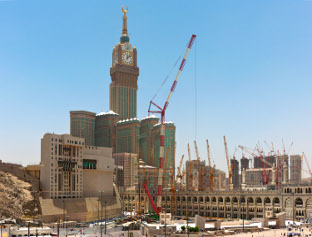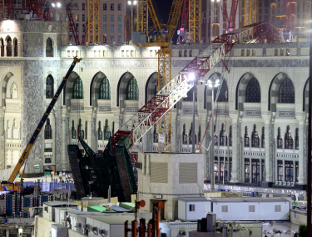After Mecca crash kills 109, a rapid response
1 October 2015When a Liebherr LR 11350 owned by Saudi Bin Ladin Group crashed at Mecca, killing 109 people, local authorities and Mammoet worked to make the site safe for pilgrims with only days to spare before the start of Hajj.
At 17:15 on the afternoon of September 11, shortly before the start of the evening prayer, a storm suddenly and unexpectedly picked up over Mecca, Islam's holiest city. A Liebherr LR 11350, used to extend access to the site for ever-increasing numbers of pilgrims, came crashing down, killing 109 visitors to the Grand Mosque.
After the accident, Liebherr released its own experts' findings, submitted to Saudi authorities. The company said wind speeds were far higher than the crane's safe operating wind speed of 9m/s. CNN reported winds reached 22m/s, while Liebherr's own data, from a tower crane anemometer at the site, showed wind speeds reaching 29m/s. These reports were backed up by computer simulations conducted locally, by the accident inquiry, and by satellite data from NASA.
The crane was working in a wind tunnel formed by the mountains around Mecca. Unlike in Western Europe and North America, where storms can often be seen as weather fronts approaching days in advance, the region is prone to sudden convective downdrafts. However, it is exceptional to see such windy conditions in the area.
Liebherr's report says the crane boom should have been lowered, a view backed up by an investigation summary released to Cranes Today by a source close to the investigation. The summary explains that the crane had been working to build a new concrete structure, the Massa, allowing millions of pilgrims to follow the path taken by Abraham's wife Hagar as she searched for water in the desert, finding it eventually at the Zamzam spring. This will be the largest concrete structure in the world.
The crane's 102m main boom+84m luffing jib had been left at an 85° boom angle, ready to resume work after the annual Hajj season. This, the report and Liebherr's experts' say, was against instructions. Instead, the boom should have been fully lowered. When the winds picked up, the crane fell into the mosque, with the hook block snapping off and crashing into the crowds.
Prince Khalid Al-Faisal Al Saud, governor of Mecca, formed a committee to investigate the accident, supported by ruler King Salman, in his role as Custodian of the Two Mosques. Compensation of SAR1m ($270,000) was paid to each of the bereaved families, and SAR0.5m to the injured.
The next step after the accident was to remove the crane, before an anticipated two million pilgrims arrived for the five-day Hajj.
Saudi authorities worked with Dar Group and Mammoet to develop a recovery plan. Dar designed temporary shorings to reinforce the Massa roof, allowing for recovery crews to work safely. Mammoet developed a lift plan for the major critical lifts.
The 20t of jib on the roof was removed using two Liebherr tower cranes already in use at the site. The main challenge was to remove the 'W-section', the lattice components used to support the luffer, which had penetrated the Massa roof two stories deep, with the building in use.
Dar Group designed a six-metre high wall to prevent the crane falling into supply lines for the Zamzam spring. The salvage team then used six Liebherr LTM 500 cranes, a Terex AC700, and two LTM 1400s to lift the main boom, as well as an LTM 1225 to hold the winch drum. One of the tower cranes was used to release the boom from the Massa facade wall.
All the major parts of the mosque have now been restored. The crane body has been surrounded by a special shelter and will be removed directly after the Hajj season.

